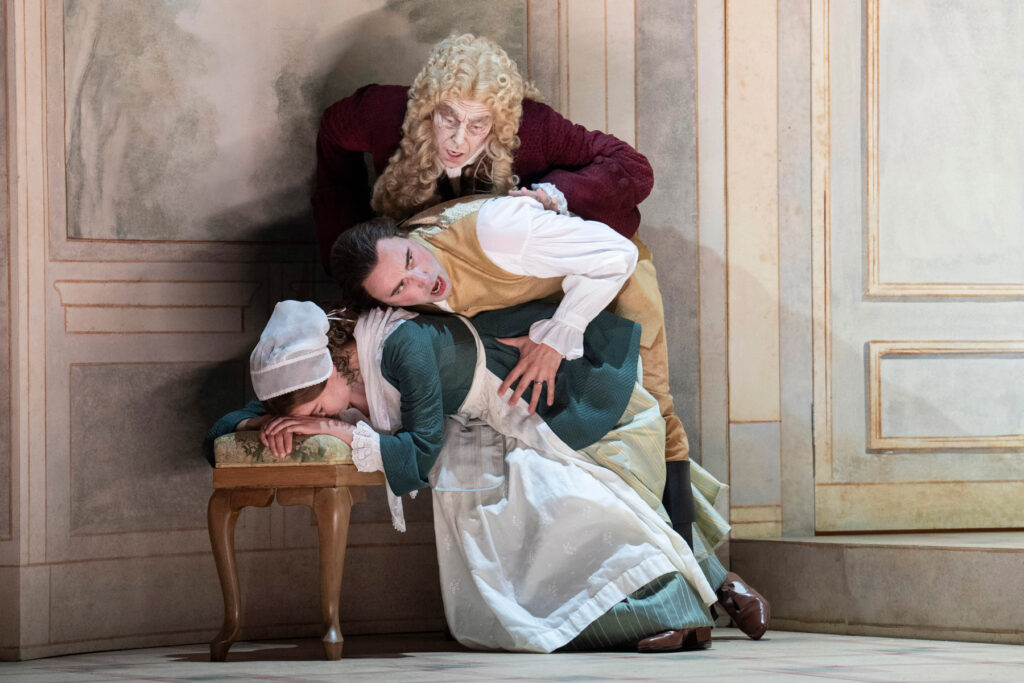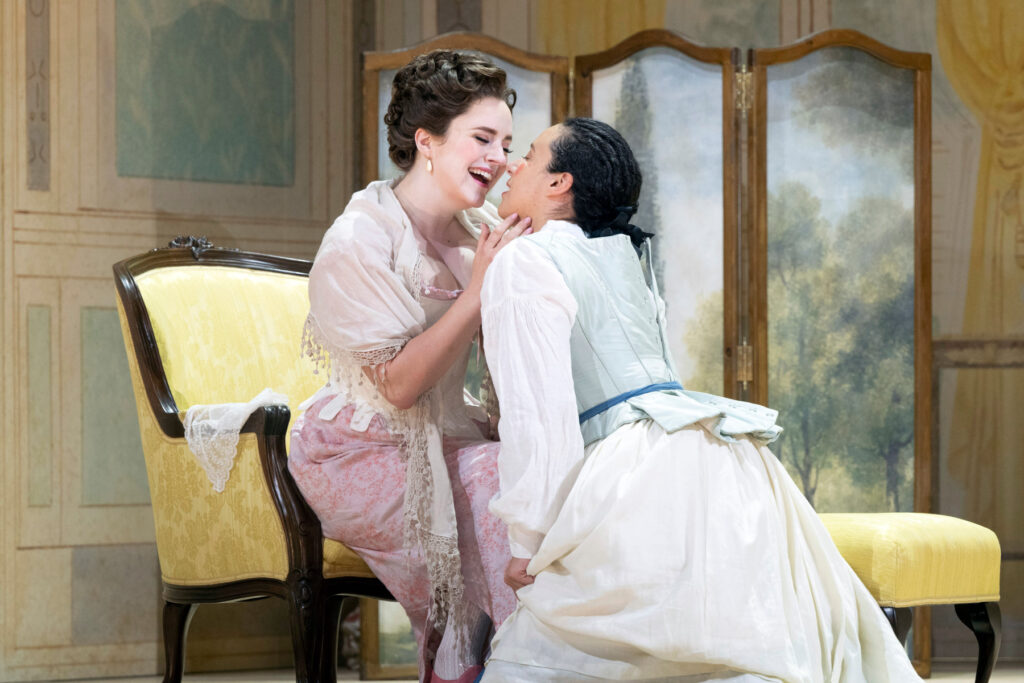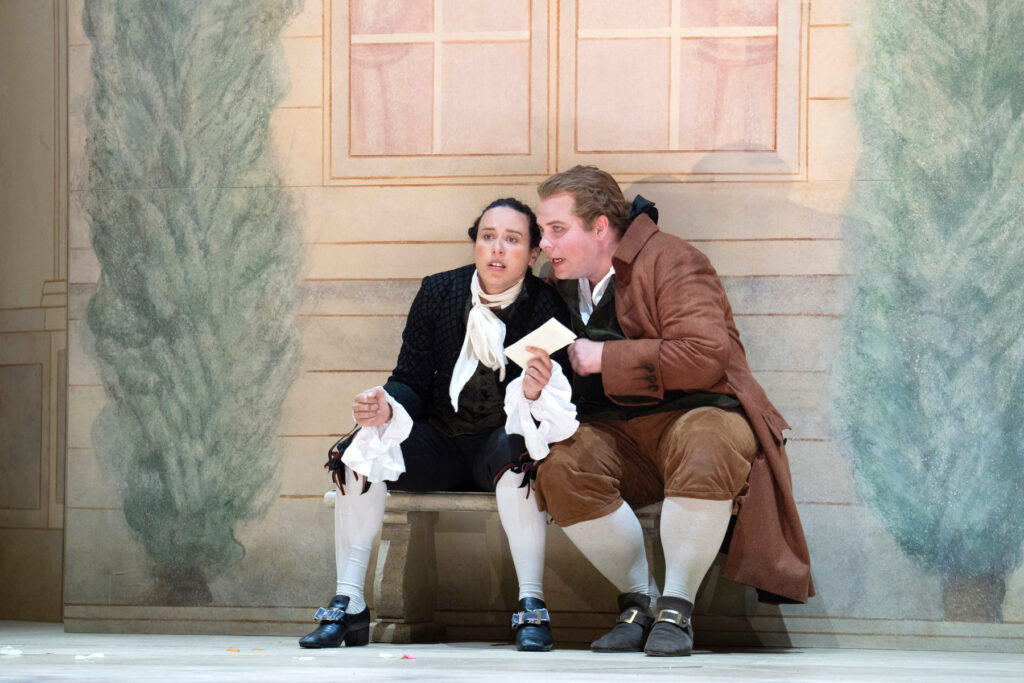Mariame Clément’s new production of Le nozze di Figaro doesn’t throw any big or provocative ideas at Mozart’s perennial masterpiece – a mainstay for Glyndebourne and its most performed opera – and it’s none the worse for it. For her, the characters are already modern, needing little interpretation, so they remain, in outward appearance, more or less exactly as they would have been seen in 1786. Inspiration for costumes and set comes from contemporary paintings by Louis Carrogis Carmontelle, whose watercolour of the young Mozart with his father and sister is well-known, and also that of Rameau.
The production isn’t a slavish or literal recreation of historical accuracy, however, but rather develops an art that effectively conceals the art of the original. The light, airy set looks deliberately designed as stage scenery and the views of the woods through the windows as though they are actually painted, instead of attempting to look entirely realistic. The constant shifting of scene and perspective within the narrative is reflected by the sets revolving frequently and flexibly among the different parts of Almaviva’s palace on this ‘day of madness’, with outer walls sliding or peeled back to reveal inner rooms and corners where the intrigue unfolds.

While ostensibly remaining true to the directions and spirit of the original, therefore, those strategies are also a reminder of the work’s innate theatricality, subtly setting the opera within an outer frame of meta-theatre. Adding to that dimension are the allusions Clément makes to the two masterpieces in which Mozart and da Ponte explored further the themes already set up in this opera. In the Act One quartet in Susanna’s room, the music master Basilio knocks out on the harpsichord the fluttering theme which accompanies his damning observation on Susanna that ‘woman are all like that’, which seems to have given rise to the idea for Così fan tutte (as well as the fast-rocking theme of its Overture). In the nocturnal garden scene of the last Act, the statue of a man presiding over the Count’s less than praiseworthy activities evidently prefigures the stone guest of Don Giovanni, further emphasised by Cherubino’s singing a brief snatch of the libertine’s ‘Champagne’ aria when he arrives to partake in the bawdy revels. More elusive in this staging is the figure of a small child who shadows the Countess’s two prominent arias. That makes for a definite picture of innocence, compared with the very worldly nature of the characters’ desires and motivations. But is it also the child the Countess wishes she could have with the Count to cement their union or, ironically, the lovechild she will have with Cherubino in Beaumarchais’s sequel to this drama of his Figaro trilogy, La Mère coupable?
Not only is the comedy of the outward action stylishly executed, but the choreography also sometimes draws out the characters’ inner musings. Almaviva delivers his aria ‘Vedrò, mentr’io sospiro’, seeking revenge on Figaro, as a confidence to the audience with the surtitles explicitly given in brackets, while the latter finishes dressing him, and so obviously not privy to the Count’s reflections. In the recapitulation of the Countess’s aria ‘Dove sono’, the repetition of the opening text “Where are now those beautiful moments” is displayed in inverted commas while she writes, as though the first draft of her thoughts for the letter that she composes in the next number with Susanna to trick the Count. The close concentration on the characters’ feelings also seems to justify the static staging of Bartolo’s revenge aria and Alessandro Corbelli’s more thoughtful not choleric delivery of it.

Otherwise, this is a musical performance that is notable for its impish, fiery temperament under Riccardo Minasi with the Orchestra of the Age of Enlightenment. There is excitement and purpose in their interpretation, the music carried forward on the period instruments’ leaner, rawer sound and some vigorous crescendos. One exception is the somewhat restrained nature of the faster section of ‘Dove sono’ which undermines the Countess’s statement of intent.
Clément has assembled a lively, committed cast of young singers as the principals in order to emphasise the inequality between the different social classes among people who, in the drama, are of a similar age. Michael Nagl’s quite sonorous bass-baritone gives expression to a serious-minded Figaro while Johanna Wallroth’s Susanna is similarly determined within a perkier, brighter musical form. Huw Montague Rendall is a raffish, almost likable Count, cultivating a suave musical profile and demeanour on stage. As his Countess, Louise Alder bears herself with stately composure in her measured account of the role, particularly in her two great arias, though she does almost succumb to a kiss with Cherubino, which is understandable in view of Adèle Charvet’s refined vocal and stage presence. Alexander Vassiliev is a relatively eloquent and lucid Antonio, not the drunken fool he is often made to be. Instead, it’s left to Ru Charlesworth and Vincent Ordonneau to provide some eccentric diversion as Basilio and Curzio respectively.

Comedy, action and characterisation are held in fine balance by Clément, making for an interpretation of the opera that is more coherent than her new Don Giovanni for Glyndebourne two years ago. We hope that she will soon complete the Mozart-da Ponte trilogy with a Così fan tutte for this festival.
Curtis Rogers
Le nozze di Figaro
Composer: Wolfgang Amadeus Mozart
Libretto: Lorenzo da Ponte
Cast and production staff:
Figaro – Michael Nagl; Susanna – Johanna Wallroth; Count Almaviva – Huw Montague Rendall; Countess Almaviva – Louise Alder; Dr Bartolo – Alessandro Corbelli; Cherubino – Adèle Charvet; Don Basilio – Ru Charlesworth; Antonio – Alexander Vassiliev; Don Curzio – Vincent Ordonneau; Barbarina – Elisabeth Boudreault; Bridesmaids – Sophie Sparrow & Biqing Zhang
Director – Mariame Clément; Designer – Julia Hansen; Movement Director – Anna-Marie Sullivan; Lighting Designer – Paule Constable; Conductor – Riccardo Minasi; The Glyndebourne Chorus and Orchestra of the Age of Enlightenment
Glyndebourne Festival Opera, Lewes, East Sussex, England, Saturday 5 July 2025
Top image: Susanna (Johanna Wallroth), Don Basilio (Ru Charlesworth), Count Almaviva (Huw Montague Rendall) and Cherubino (Adèle Charvet)
All photos © Glyndebourne Productions Ltd. Photography by Richard Hubert Smith